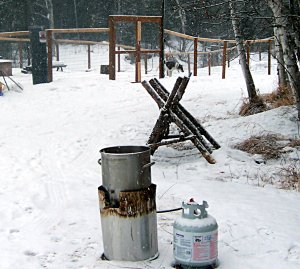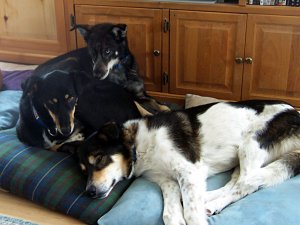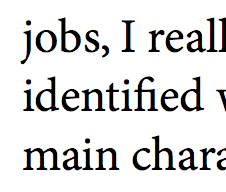
firefox screenshot, fi ligature
I’ve been trying out the latest firefox beta (3.0b5) on my Mac, which is supposed to be the final beta before the release candidates. Mozilla expects that firefox 3.0 will be out in June. While looking over my blog post about The Wind-Up Bird Chronicle I noticed that the browser was automatically selecting the ‘fi’ glyph whenever it encountered these two characters together. The image on the right is a screenshot showing the actual rendering using Adobe Minion as the browser font. Notice that the third letter ‘i’ in the word ‘identified’ has no dot on it because the dot would collide with the ball at the tip of the ‘f’ letter preceding it. As far as I know, not even Microsoft Word can do this. Pretty sad when a supposedly fully functional word processor from the world’s largest and most powerful software company can’t even incorporate a feature that’s built into an open-source web browser (and which has been part of TeX since it's beginnings in 1978).
Admittedly, this feature looks a little strange when implemented on a font that doesn’t do it very well (like Geneva, which had been the default for my browser until I switched to Adobe Myriad), but at least the ability is there now. I looked on the about:config page to see if there was a way to turn it off for those situations where you’re stuck with a lame font, but I didn’t find any options related to ligatures.
The Wind-Up Bird Chronicle is Haruki Murakami’s most well regarded book, and the first of his books I’ve read. I’m sure I will be reading more. It reminded me a lot of Paul Auster, another of my favorite authors. In both author’s books, reality is often in question, there are many threads to the story that are often tied up together in unlikely ways, and characters suffer strange fates in isolating places.
Here, the book begins with the out-of-work main character looking for his cat, taking care of the house while his wife is at work. As the story progresses, stranger and stranger things start happening to him, and eventually, you wonder which parts of the story are real and what parts are imagined. But unlike many stories like this, very little suspension of disbelief is required.
I enjoyed everything about the book. The historical digressions into Japan’s wartime campaign in Manchuria were fascinating after reading Human Smoke, it was good to read a book with women in it for a change (I’ve been reading a lot of dry non-fiction recently), and as someone taking a vacation between jobs, I really identified with the main character and his struggles to understand the world around him and where he fit into it.
Highly recommended.
A few weeks ago we ordered some Flor for our bedroom. It’s a rug system composed of a series of Flor “tiles” that are each 19.7" x 19.7". They show up in what look like oversized pizza boxes. The tiles are joined together underneath, at the corners, using thin adhesive discs. The carpet fibers are embedded in a rubbery substrate, which means you can cut the tiles however you want without worrying about a frayed edge (you can see we edged our rug using half-tiles that I cut with a carpet knife), and it’s a soft enough material that the rug doesn’t move around even on a slippery faux-wood floor like we have in the bedroom. Best of all, if something happens to the carpet in a particular place, the affected tile can be lifted out from the rug, cleaned or replaced, and fitted back into place. The carpeting in the Akasofu Building where I used to work was of a similar design, but Flor is primarily intended for non-commercial uses.
We ordered something they call “Tonal Vision”, which is a combination of three different styles of tile, each style in two different colors. It comes in red, cream, or blue. I’m glad we chose this option because we can see the differences between three of the styles they sell. “Solid Ground” is very low and soft, with almost no texture at all, and has a slightly beveled edge. The beveled edge would make more sense for a continuous carpet in this style, but it’s such a minor feature that you don’t really notice it when combined with tiles of different colors and textures. “Toy Poodle” is most similar to a normal rug, and “House Pet” has a really interesting, tactile texture like the scrubby side of a scrubby sponge. The six colors do go together quite well, but we’ve discovered that Solid Ground seems to attract dog hair, and because these tiles are so smooth, and are both lightly colored, it’s pretty obvious. We haven’t tried our carpet sweeper on it yet, but hopefully it’ll be able to pick up most of the dirt that’s on the surface of the Flor.
I’m really happy with the way it turned out, and I expect we’ll be buying more of it when we’ve come up with a decorating plan for the other rooms in the house.
Still on vacation. I just finished brewing my second batch of beer in the last week. It was originally called “Barking Buddy”, named after our biggest sled dog Buddy, but because of the heavy snow we’ve been getting today, I decided to rename it “Barking Buddy Blizzard Bitter.” All this snow is odd because early last week we had daytime highs in the 50s and the snow on the ground was rapidly melting. Suddenly, it looks a lot more like winter than spring. The top photo shows the start of the boil; that’s Buddy in the dog yard in the background of the photo.
Devil Dog Rye IPA fermented nicely over the past week, going from a gravity of 1.086 down to 1.022 at transfer to the secondary fermenter (a keg). I left for a funeral the day after I brewed it and put Andrea in charge of monitoring the temperature and the location of the fermentation chamber’s insulated lid. I removed the lid the morning after brewing because the yeast was going crazy and the wort temperature was up to 75°F. The wort was pitched on top of the yeast cake from the primary fermentation of my previous batch, and that’s why I got such a rapid fermentation and high temperature despite the high starting gravity. I was worried that there might be some off-flavors from the heat, but the beer tasted really good when I transferred it so I think it’ll be OK. Without Andrea’s help, it probably would have either gotten even hotter (if I’d left the lid on) or gotten too cold and I would have returned from Chicago to a stuck fermentation.
Today’s brew was relatively uneventful. I got another very high mash efficiency (85%!) this time around. As I mentioned in my last brewing post, I suspect this is due to my new mill, but it could also be the longer mashing times I’ve used, or the change in base malt (Castle Pale to Crisp Maris Otter). I’m happy that my yields are back up again, but it’s unfortunate that I changed all three variables at the same time so I can’t positively assign a cause to the improvement. I also hit my target pitching temperature of 66°F on the nose this time, so I’m finally getting the hang of the pump I’m using to circulate cold water through the plate chiller. It’s all good.
The second photo shows Kiva’s reaction to the dog beds being occupied. Buddy has a tendency to stretch himself out across two beds, and when Koidern nestled in next to Buddy there was no room for Kiva. But rather than moving to one of the other beds we’ve got, she wedged in behind Koidern. In the photo she’s giving Koidern the stink-eye, trying to get her to move. Didn’t work, and eventually all three went to sleep all packed together on the two beds.
One more day of vacation until the weekend. I’m looking forward to smoking salmon, working on a side table for Andrea, and relaxing.
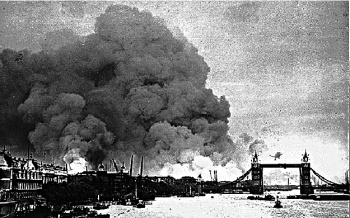
london burning, sep 1940
The afterword and dedication of Human Smoke: The Beginnings of World War II, the End of Civilization tells you a lot about the perspective Nicholson Baker has in telling the story of World War II up to January 1942:
This book ends on December 31, 1942. Most of the people who died in the Second World War were at that moment still alive. Was it a “good war”? Did waging it help anyone who needed help?
. . .
I dedicate this book to the memory of Clarence Pickett and other American and British pacifists. They’ve never really gotten their due. The tried to save Jewish refugees, feed Europe, reconcile the United States and Japan, and stop the war from happening. They failed, but they were right.
Whether or not a different approach to the “Great War” would have helped those who needed help cannot be answered, but after reading this book you will truly see how horrifying the war was, and how those who waged it contributed to it’s horrors. That the title of the book refers to the smoke from the incinerators at Auschwitz should be enough to give you pause over whether you want to read this book. It’s pretty devastating. But it does serve as a powerful antidote to the false historical idea that the Allies fought the good fight to liberate the world from the Axis evil. There’s not much good in war, even a “necessary” war like World War II, and there was plenty of evil among all leaders engaged in the struggle.
I found three main threads in the book. First, and probably most important was the nature of the way the war was brought to the citizens of Europe. Cities on both sides were bombed using brutal techniques that typically started with incendiary bombs to set blacked-out targets on fire, followed by high energy exposives targeting the fires themselves (if it’s burning, it must be something worth destroying), and ending with delayed-action bombs “so as to prevent or seriously interfere with fire fighting, repair and general traffic organization” (from a British Air Ministry report on bombing policy, April 24, 1941). Churchill is quoted several times using the phrase “Business before Pleasure” to describe targeting military targets before civilian ones. Despite this intention, the vast majority of British and German bombs fell on citizens, not military targets. The British blockade of Europe also brought the war to Axis countries in the form of famine. Churchill explained that fats make bombs and potatoes make synthetic fuels that would be used against Britain. Herbert Hoover wrote: “The notion that the special type of food we needed for children (milk, chocolate, fats, and meat) would be used for munitions was sheer nonsense.” As in Bush’s war in Iraq, Hoover quotes the old adage: truth is war’s first fatality.
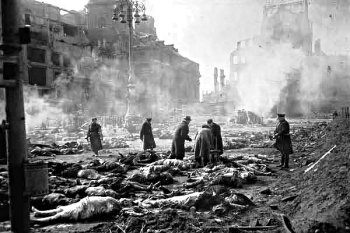
dresden firebombing, feb 1945
The second main thread concerns the plight of the Jews. It appears from the quotes in this book as though Hitler’s main objective was to remove the Jews from Europe, and when he could find no place to send them (including Palestine, Madagascar and any other country willing to take them), he began his program of extermination. Again, there’s no way to know what might have happened if the Allies had offered refuge to the Jews in Axis countries, but it’s hard to imagine anything worse than what happened.
The final argument working through the book is the ways in which the United States goaded the Japanese into their pre-emptive strike on Pearl Harbor. Without all the evidence, it’s hard to decide if this is a valid argument, but it is clear that the United States had many opportunities to relax tensions with Japan and prevent a Pacific war. Instead we were supplying the Chinese and Soviets with bombers, fuel, pilots and training, while at the same time, building up our own bases surrounding Japan. Churchill seemed convinced that the United States would enter the war once the Germans started bombing England, and then when France fell, but it took the attack on Pearl Harbor to get us in. Baker’s book has something to say about how that happened.
These three main arguments, and others, weave their way through the book’s chronologically arranged short presentations of facts. It’s a very effective way to make a simple argument about the nature of war, and despite the horrors on the page, it’s an entertaining way to receive history. The problem is that without any objective (or even subjective) interpretation of the passages, or a stated intention toward balance and objectivity, it’s hard to evaluate the arguments that formed in my mind. I have no doubt about the facts Baker includes, but there are likely to be facts that don’t follow the general patterns on display. Nevertheless, if you’re interested in what lead up to the entry of the United States into World War II, or if you have doubts about the heroic storyline presented in the multitude of “Great War” documentaries, this book should be included alongside more traditional historical accounts of the war.


